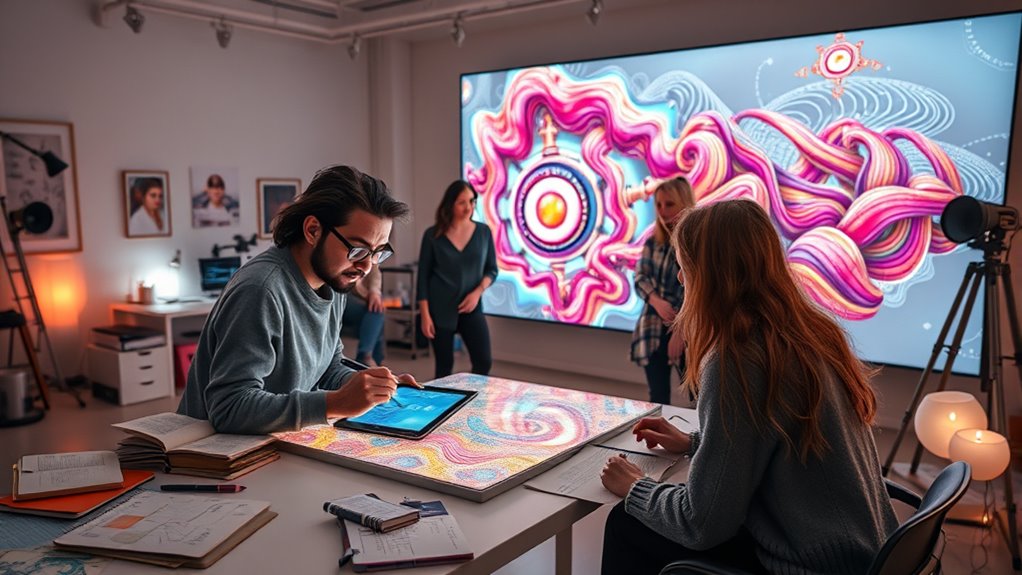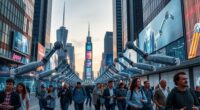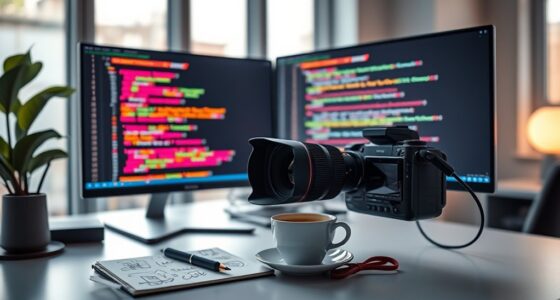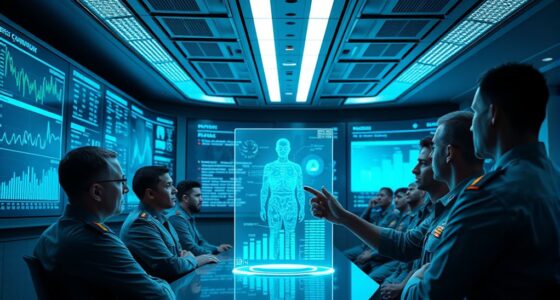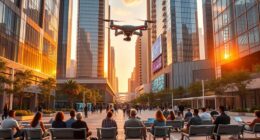You’re witnessing a new era where artists and writers team up with AI to push creative boundaries. AI tools like generative models help generate unique images, stories, and multimedia works, making collaboration more accessible and inspiring innovation. They automate repetitive tasks and spark new ideas, while human elements like emotion and authenticity remain essential. If you want to explore how this partnership is shaping art and storytelling today, there’s much more to discover ahead.
Key Takeaways
- Artists and writers collaborate with AI as a creative partner to generate unique styles, ideas, and multimedia projects like AR and gaming.
- AI automates repetitive tasks, enabling creators to focus on innovation and explore unconventional artistic expressions.
- Human elements such as emotional depth and authenticity remain essential, with AI supporting editing, idea generation, and data analysis.
- Ethical considerations include transparency, respecting copyrights, and safeguarding AI models against vulnerabilities like hacking.
- The partnership fosters hybrid artworks, rapid prototyping, and expanded audience reach, transforming traditional creative processes.
Embracing AI to Unlock New Creative Horizons
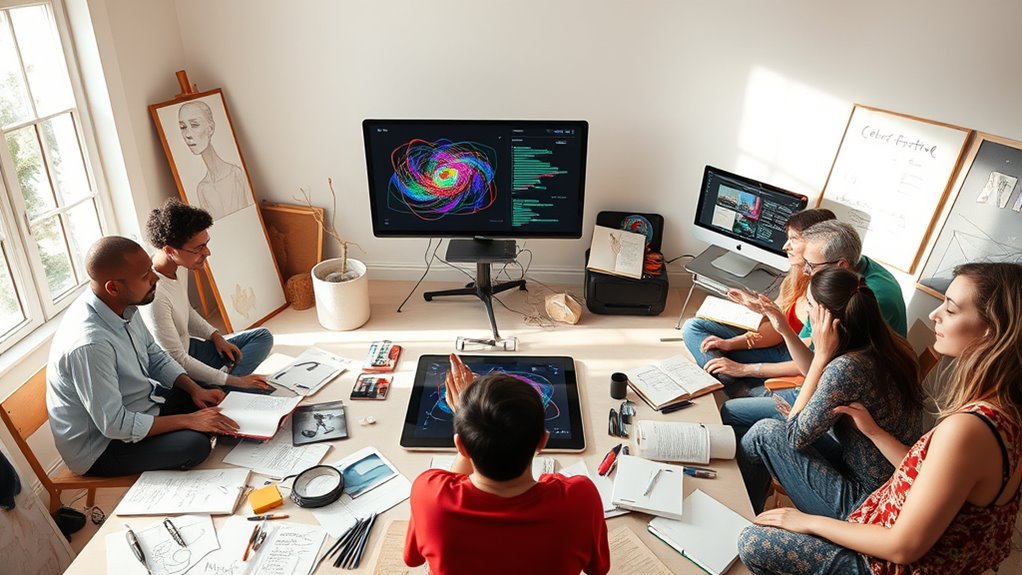
Embracing AI has revolutionized the way artists and writers explore their creativity, opening doors to new artistic horizons that were previously unreachable. You can now generate diverse artworks using AI tools like ArtBreeder and GanBreeder, which create surreal visuals through generative models such as GANs. With collaborative software like Photoshop and Figma, merging AI features with your workflow becomes seamless, making design easier and more dynamic. Interactive installations, like those by Rafael Lozano-Hemmer, respond to viewer input, creating immersive experiences. AI also automates repetitive tasks, freeing you to focus on innovation. By integrating AI into your creative process, you gain access to novel ideas and techniques, pushing boundaries and exploring uncharted artistic territories with confidence. Sougwen Chung’s work exemplifies how AI can facilitate new forms of human-machine collaboration in art. Additionally, understanding the role of algorithms in generating visual content can help artists refine their creative outputs and experiment with new styles. Recognizing the impact of machine learning on art creation allows creators to better harness these technologies for unique expressions. Moreover, incorporating design principles from traditional art can enhance how AI-generated visuals are integrated into cohesive projects. Furthermore, being aware of Resources and Tools such as legal resources and local knowledge can help artists navigate intellectual property considerations and ethical implications of AI art. Additionally, being aware of safe sleep environments for infants can inspire creative themes around safety and care within artistic projects.
Enhancing Productivity and Innovation in Content Creation
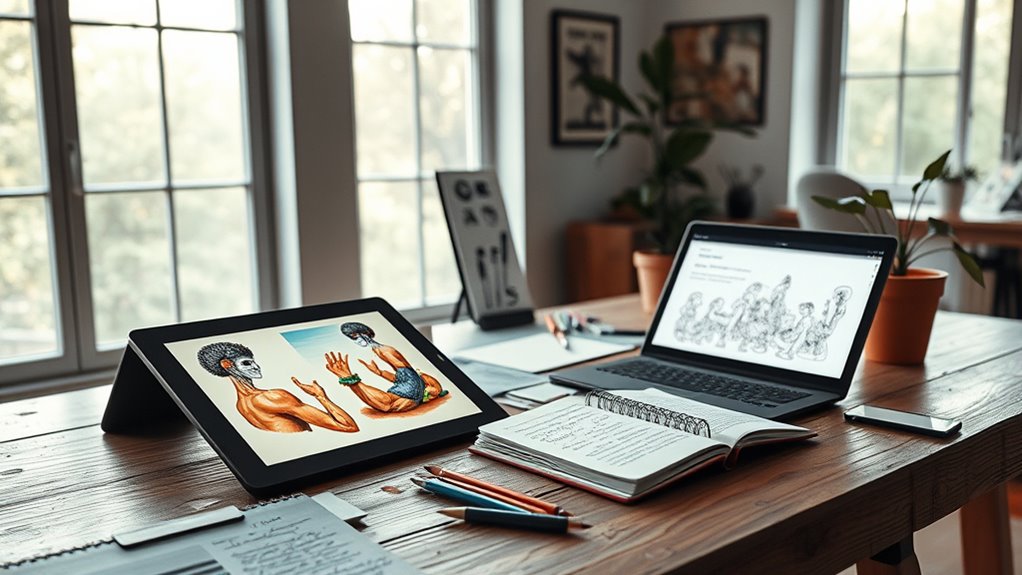
Integrating AI into your content creation process considerably boosts productivity and sparks innovation. AI automation helps you complete more projects faster—developers, for example, finish up to 126% more weekly, and organizations report higher overall efficiency. It relieves you from repetitive tasks like research and editing, freeing up time for higher-level creative work. Content marketers leverage AI for ideation and drafting, making concept generation more diverse and rapid. AI also analyzes data to inform better audience targeting, driving engagement. With tools supporting experimentation and personalization, you can test variations quickly and explore new styles without heavy resource investment. As AI adoption grows—78% of organizations are integrating it—your workflow becomes more streamlined, enabling continuous innovation and a competitive edge in content creation. Incorporating proper care and maintenance practices ensures that AI tools operate effectively and responsibly, safeguarding quality and ethical standards in your projects. Additionally, understanding vegetable juices can inspire new health-focused content and creative marketing strategies. Furthermore, leveraging AI content clusters allows for more targeted and interconnected content, boosting your overall SEO performance. Recognizing content regulation is essential for maintaining compliance and building trust with your audience. Regular updates and software updates help keep your AI tools functioning optimally and secure from vulnerabilities.
The Role of Human Touch in an AI-Driven Workflow
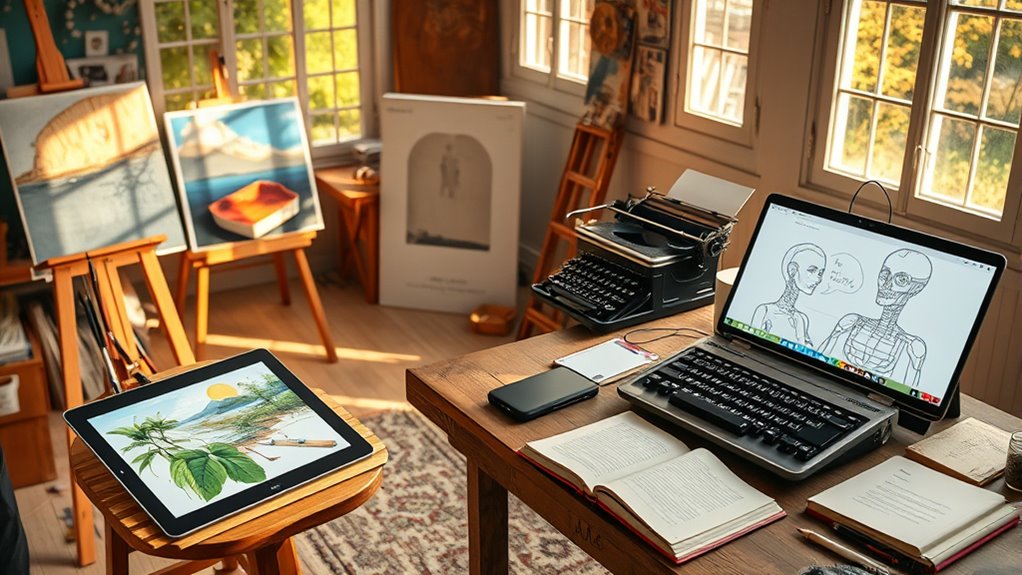
As AI tools streamline content creation and boost productivity, maintaining the human touch becomes increasingly important. Consumers still prefer content that feels authentic and emotionally engaging, which AI alone can’t fully deliver. Your role is to infuse your work with genuine emotion and perspective, ensuring your audience connects on a deeper level. AI can help with routine tasks, freeing you to focus on creative and emotional nuances. To balance efficiency and authenticity, consider this table:
| Human Element | AI Contribution |
|---|---|
| Emotional depth | Automates editing |
| Personal insight | Generates ideas |
| Authenticity | Data analysis |
| Unique voice | Content suggestions |
Keeping your human touch ensures your work remains relatable and trusted, even in an AI-driven process. Research indicates that audiences respond more positively to content that reflects authentic human experiences and emotional resonance, underscoring the importance of your personal input. Additionally, AI in education is transforming learning experiences, but the human element remains vital for meaningful engagement. Incorporating creative techniques can further enhance the authenticity of your work by adding unique perspectives that only humans can provide. Recognizing the power of emotion in storytelling helps maintain an authentic connection with your audience despite technological advances. Moreover, understanding the role of authenticity in content creation is essential for building trust and loyalty among your audience. Developing emotional intelligence can also help you better gauge your audience’s needs and reactions, fostering stronger connections.
Overcoming Challenges: Ethical and Practical Considerations
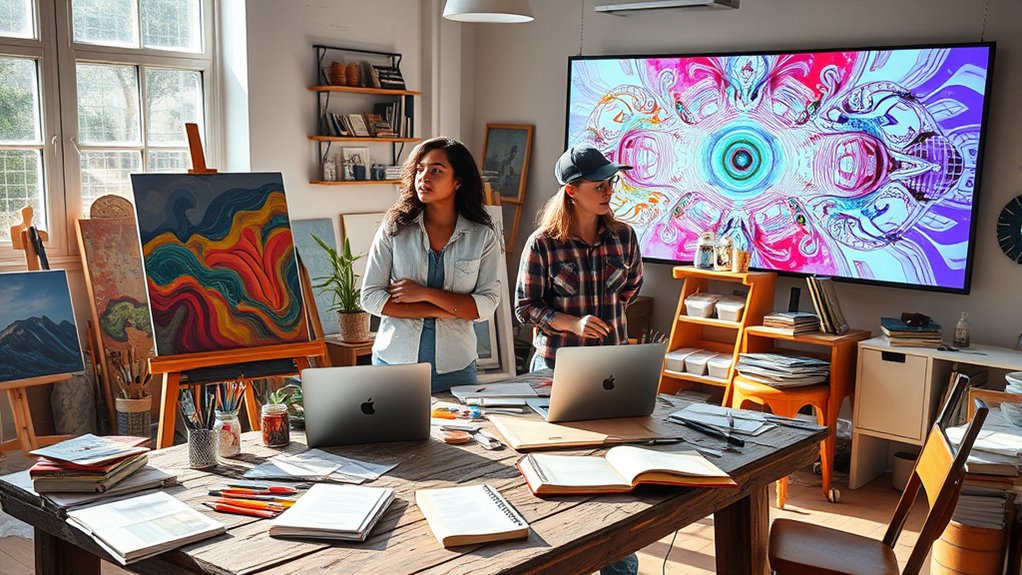
As you explore AI’s role in art and writing, you’ll need to balance authenticity with innovation, ensuring your work remains genuine. Steering ethical boundaries means respecting creators’ rights and maintaining transparency about how AI is used. By focusing on content integrity, you can harness AI’s potential while upholding responsible practices. Additionally, understanding the lack of legal recognition for AI-generated works helps you navigate ownership and protect your creative contributions. Recognizing content authenticity is essential to maintain trust and credibility in your work amidst evolving AI capabilities. Staying informed about Textile Line innovations can also inspire new approaches in integrating technology with traditional art forms. Being aware of current news in Indonesia can also inform your understanding of societal values and ethical standards relevant to your creative process. It’s important to consider how Pimple Patch concepts might influence your approach to authenticity and consumer trust in AI-generated content.
Balancing Authenticity and Innovation
Balancing authenticity and innovation in AI-assisted creative work requires steering through both ethical and practical challenges. You must be aware that AI-generated content often lacks the personal voice and emotional nuance that only humans can provide. There’s also the risk of bias, which can compromise credibility and authenticity if left unchecked. While AI can push creative boundaries and boost efficiency, it struggles with originality and deep contextual understanding. To maintain integrity, you need to combine AI’s capabilities with your unique perspective, ensuring your work remains genuine. Careful editing and transparency about AI’s role help preserve trust. Additionally, AI-generated content often feels impersonal and lacks genuine creativity, which underscores the importance of human oversight. Ultimately, finding the right blend of human touch and technological innovation allows you to create authentic, forward-thinking content without sacrificing credibility.
Navigating Ethical Boundaries
Guiding ethical boundaries in AI-assisted creativity requires you to confront complex issues around consent, intellectual property, and transparency. AI models often train on copyrighted works without explicit permission, raising concerns about theft and rightful recognition. Without clear legal protections, creators struggle to enforce their rights, leading to calls for regulations that mandate transparency about training data and licensing agreements. Respecting artist copyrights and exploring licensing options help legitimize AI-generated works. Transparency is key—disclosing AI’s role maintains trust and prevents misleading audiences. Additionally, accountability measures like documenting datasets ensure traceability. In 2023, discussions about AI’s legal implications have intensified, highlighting the urgent need for comprehensive regulations. Balancing innovation with ethical responsibility means respecting creators’ rights, avoiding bias, and fostering fairness. Navigating these boundaries is essential to ensure AI enhances rather than exploits human creativity.
Ensuring Content Integrity
Ensuring content integrity in AI-assisted creative processes involves addressing significant ethical and practical hurdles. You need to safeguard AI models against vulnerabilities like hacking, which can lead to misinformation, data breaches, and loss of trust. Proper data governance is essential to minimize bias and errors, ensuring the AI’s outputs are reliable. Transparency is also indispensable; AI models often act as “black boxes,” making it hard to explain decision-making, which hampers regulatory compliance and public trust. You must implement strict security measures and develop clear guidelines to prevent research misconduct and detect AI-generated content accurately. Prioritizing ethics training and establishing governance frameworks help maintain integrity, ensuring your AI tools support fair, trustworthy, and responsible creative work.
Transforming Artistic Expression Through Generative AI
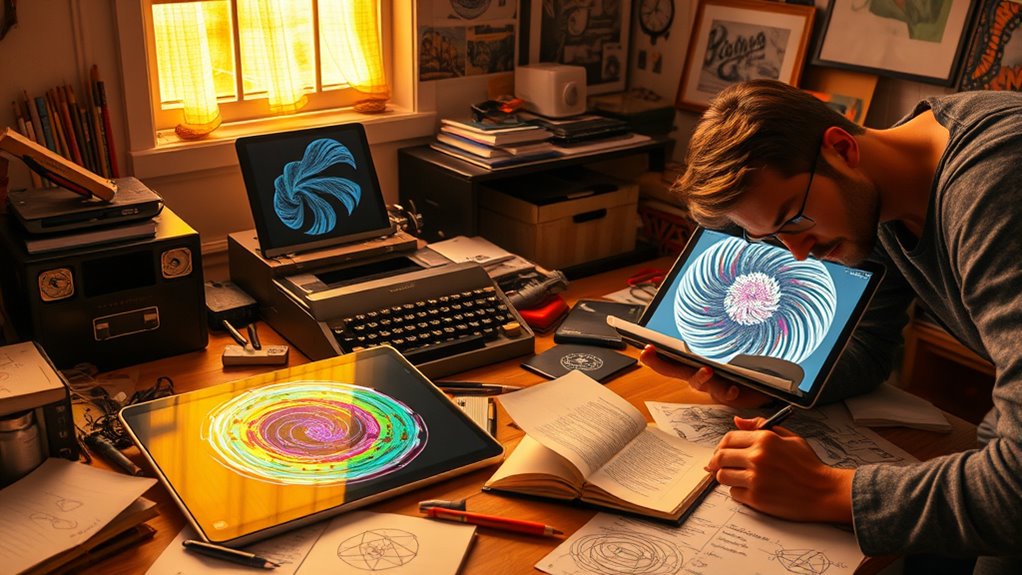
Generative AI is redefining how you create art, breaking down traditional barriers and opening new horizons for expression. It empowers you to push beyond limits and experiment with ideas that once seemed impossible. This technology also fosters fresh collaborations, inspiring artists and writers to work together in innovative ways.
Expanding Creative Horizons
As AI technology advances, artists and writers are discovering new ways to push the boundaries of creative expression. You can explore innovative art forms like AI-generated music and visual art, which challenge traditional boundaries. The market for AI-driven art is rapidly growing, expected to increase from $0.43 billion in 2024 to $0.62 billion by 2025. AI models are becoming more accessible and powerful, helping you develop unique styles and ideas. Additionally, AI’s integration into media like augmented reality and game design opens new creative avenues. Companies are also leveraging AI for commercial projects, expanding opportunities for artists and writers to experiment with fresh formats and reach wider audiences.
- Discover new art styles with AI-generated visuals and music.
- Use accessible AI tools to refine your creative process.
- Incorporate AI into multimedia projects like AR and gaming.
- Participate in AI art awards and exhibitions to showcase your work.
Overcoming Artistic Barriers
Advancements in AI are opening up new possibilities for artists and writers to overcome traditional barriers to creative expression. AI tools lower entry costs and simplify complex techniques, making art more accessible. They help artists with limited resources or skills experiment freely, regardless of physical or cognitive challenges. AI’s speed allows quick creation, reducing time and expense for beginners. You can explore diverse styles or combine genres effortlessly.
| Benefit | Impact |
|---|---|
| Accessibility for all | Inclusive art creation |
| Style experimentation | Breaking traditional boundaries |
| Rapid prototyping | Faster development of ideas |
| Skill growth | Learning through AI-generated variations |
AI empowers you to push past obstacles, transforming your artistic journey.
Inspiring New Collaborations
AI is transforming artistic collaboration by acting as a creative partner that expands your possibilities. It enables you to push beyond traditional limits, fostering innovative hybrid art forms. You can co-create with AI, blending human insight with machine-generated content for unique outputs. This collaboration accelerates processes, allowing rapid prototyping and iteration that bring ideas to life faster. The economic impact is significant, with AI’s role in art and design projected to reach $40.3 billion by 2033, increasing visibility and acceptance. Through AI, you can explore new styles, narratives, and interdisciplinary partnerships that were previously unthinkable. These collaborations help break barriers, inspire fresh creative directions, and reshape how art is produced and experienced.
- Co-create hybrid artworks blending human and AI input
- Accelerate project development with rapid iteration
- Explore unconventional styles and narratives
- Foster interdisciplinary partnerships for innovative art forms
Collaborations and Co-Creations: Blending Human and Machine
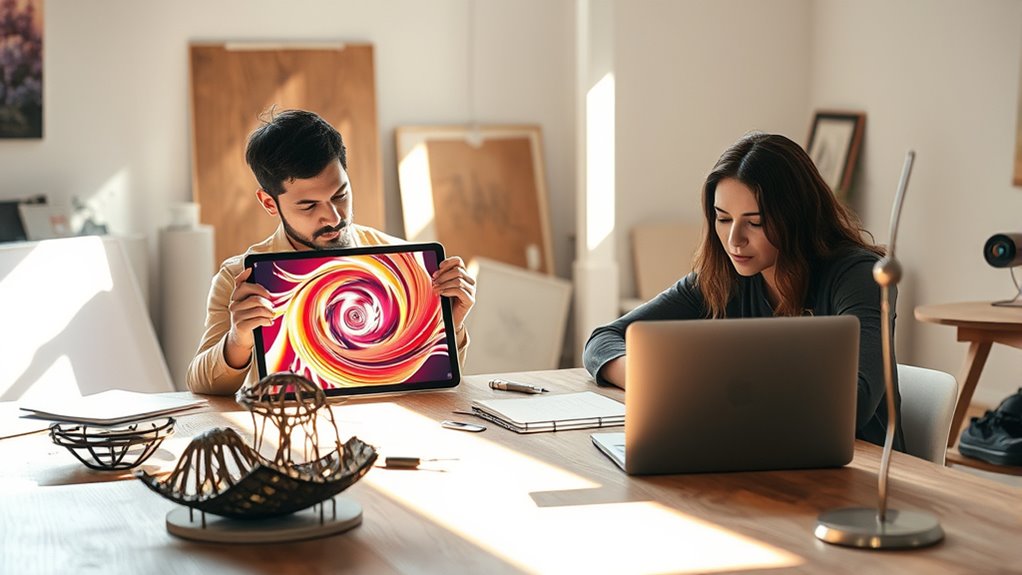
Collaborations between artists, writers, and machines are transforming the creative process by blending human intuition with machine-generated insights. You can leverage AI to discover novel suggestions, patterns, and ideas that might not be immediately obvious. Creative professionals find AI tools stimulate experimentation, helping break routine and explore new styles. AI-driven co-creation often results in work beyond human capability alone, thanks to its computational power for handling large data sets and complex patterns. In practice, web designers use AI for layouts and color schemes, while writers get narrative suggestions, and artists incorporate AI-generated imagery into digital art. Musicians analyze genres with AI, and rapid prototyping allows you to focus on refining your vision. This synergy pushes creative boundaries, fostering innovation and opening new artistic possibilities.
Future Outlook: Trends and Opportunities in Creative AI
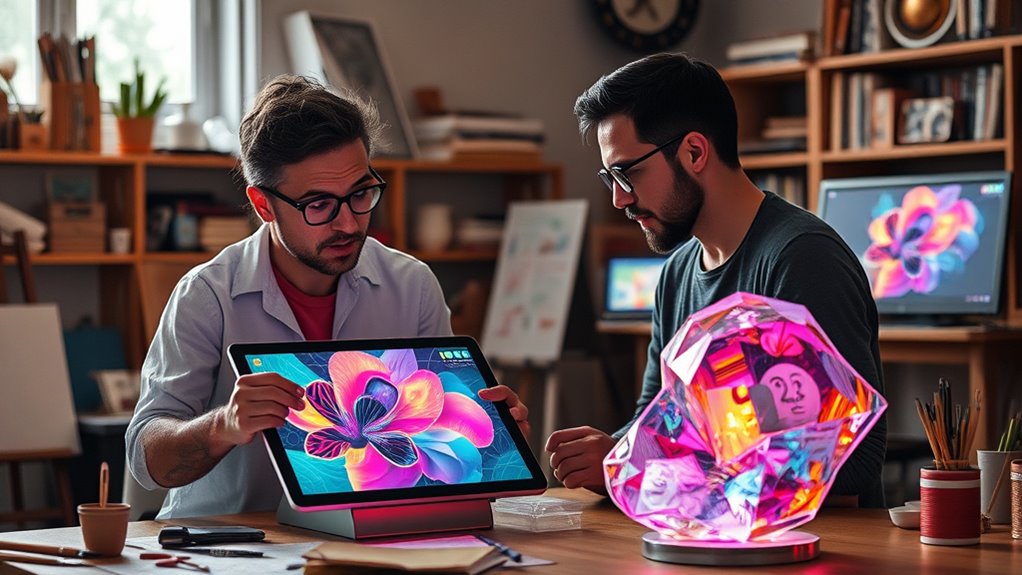
As creative tools evolve, multichannel and multimodal inputs are opening new horizons for artistic expression. You can now work across text, voice, images, and video, expanding what’s possible. Tools like NotebookLM enable AI to generate complex outputs from documents, making storytelling more immersive. Multimodal inputs lead to innovative engagement, such as AI-created podcasts and interactive narratives. Integration across media channels is transforming creative workflows in 2025, making AI an operational tool for diverse outputs beyond just text.
Here are some key trends:
- AI’s growing autonomy in handling creative tasks with minimal human input.
- Enhanced personalization and predictive analytics shaping tailored experiences.
- Increased investment in talent and technology to support human-AI collaboration.
- AI’s expanding role across industries like healthcare, entertainment, and education.
Frequently Asked Questions
How Do Artists Ensure Authenticity When Using Ai-Generated Content?
You can guarantee authenticity by using AI tools to verify your work, like pattern recognition and forgery detection, which analyze your art’s unique features. Keep detailed records of your creative process and AI’s role, showing transparency. Collaborate openly with critics and audiences, explaining how AI contributes. By combining technology with honesty, you build trust and demonstrate your genuine artistic voice, even in AI-assisted creations.
What Skills Are Essential for Creatives Working With AI Tools?
You need a mix of skills to work effectively with AI tools. Craft clear prompts and refine them to get the results you want. Understand each tool’s strengths and limitations, and verify outputs to avoid errors. Stay updated on new features, and be ready to troubleshoot. Collaborate with others, explain your process, and balance automation with originality. These skills help you harness AI creatively and ethically.
How Does AI Impact Job Opportunities in Creative Industries?
You might think AI is a double-edged sword, but it really reshapes job opportunities in creative industries. It’s automating tasks, which can threaten jobs, yet also creates new roles like AI trainers and ethicists. While some jobs may disappear or change, AI opens doors for collaboration and innovation, expanding possibilities. Staying adaptable and learning new skills will help you navigate the shifting landscape and seize emerging opportunities.
What Legal Issues Arise From Ai-Created Artworks and Writings?
You face legal issues with AI-created artworks and writings, mainly around copyright ownership. Since courts require human authorship for protection, AI works often lack legal rights. Training AI on copyrighted content also raises concerns about infringement and unauthorized use. Without clear laws, you risk legal disputes, especially if your work is used without permission or if you try to claim copyright for AI-generated pieces.
How Can Ethical Guidelines Be Implemented for AI in Art and Writing?
You can implement ethical guidelines for AI in art and writing by establishing clear standards for transparency, consent, and attribution. Make sure creators log training data sources and disclose AI involvement in their work. Encourage verification of AI outputs, respect intellectual property rights, and promote accountability through accessible documentation. Industry and government policies should support ongoing education, address biases, and adapt regulations to guarantee responsible use of AI in creative fields.
Conclusion
As you explore this new frontier, remember that AI isn’t replacing your creativity—it’s amplifying it. Like a trusted co-creator, AI opens doors to endless possibilities, transforming your ideas into vivid realities. Embrace the blend of human passion and machine innovation, and watch your artistry flourish beyond borders. After all, in this partnership, you hold the brush—AI simply adds a splash of color. So, are you ready to shape the future of creativity?
